| Listing 1 - 6 of 6 |
Sort by
|
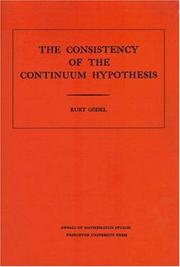
ISBN: 0691079277 1400881633 9780691079271 Year: 1970 Volume: 3 Publisher: Princeton (N.J.): Princeton university press,
Abstract | Keywords | Export | Availability | Bookmark
 Loading...
Loading...Choose an application
- Reference Manager
- EndNote
- RefWorks (Direct export to RefWorks)
Kurt Gödel, mathematician and logician, was one of the most influential thinkers of the twentieth century. Gödel fled Nazi Germany, fearing for his Jewish wife and fed up with Nazi interference in the affairs of the mathematics institute at the University of Göttingen. In 1933 he settled at the Institute for Advanced Study in Princeton, where he joined the group of world-famous mathematicians who made up its original faculty. His 1940 book, better known by its short title, The Consistency of the Continuum Hypothesis, is a classic of modern mathematics. The continuum hypothesis, introduced by mathematician George Cantor in 1877, states that there is no set of numbers between the integers and real numbers. It was later included as the first of mathematician David Hilbert's twenty-three unsolved math problems, famously delivered as a manifesto to the field of mathematics at the International Congress of Mathematicians in Paris in 1900. In The Consistency of the Continuum Hypothesis Gödel set forth his proof for this problem. In 1999, Time magazine ranked him higher than fellow scientists Edwin Hubble, Enrico Fermi, John Maynard Keynes, James Watson, Francis Crick, and Jonas Salk. He is most renowned for his proof in 1931 of the 'incompleteness theorem,' in which he demonstrated that there are problems that cannot be solved by any set of rules or procedures. His proof wrought fruitful havoc in mathematics, logic, and beyond.
Mathematical logic --- Mathematics --- Logic, Symbolic and mathematical --- Mathématiques --- Logique symbolique et mathématique --- Philosophy --- Philosophie --- Logic, Symbolic and mathematical. --- Philosophy. --- Set theory --- Théorie des ensembles --- Continuity --- Continu (philosophie) --- Algebra of logic --- Logic, Universal --- Symbolic and mathematical logic --- Symbolic logic --- Algebra, Abstract --- Metamathematics --- Syllogism --- Logic of mathematics --- Mathematics, Logic of --- Absoluteness. --- Addition. --- Axiom of choice. --- Axiom of extensionality. --- Axiom of infinity. --- Axiom. --- Axiomatic system. --- Boolean algebra (structure). --- Constructible set (topology). --- Continuum hypothesis. --- Existence theorem. --- Existential quantification. --- Integer. --- Mathematical induction. --- Mathematical logic. --- Mathematics. --- Metatheorem. --- Order by. --- Ordinal number. --- Propositional function. --- Quantifier (logic). --- Reductio ad absurdum. --- Requirement. --- Set theory. --- Theorem. --- Transfinite induction. --- Transfinite. --- Variable (mathematics). --- Well-order. --- Théorie des ensembles --- Logique mathématique --- Axiome du choix
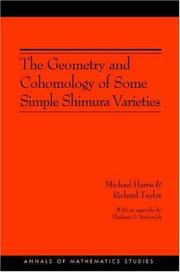
ISBN: 1400837200 9781400837205 0691090920 9780691090924 Year: 2001 Publisher: Princeton Oxford Princeton University Press
Abstract | Keywords | Export | Availability | Bookmark
 Loading...
Loading...Choose an application
- Reference Manager
- EndNote
- RefWorks (Direct export to RefWorks)
This book aims first to prove the local Langlands conjecture for GLn over a p-adic field and, second, to identify the action of the decomposition group at a prime of bad reduction on the l-adic cohomology of the "simple" Shimura varieties. These two problems go hand in hand. The results represent a major advance in algebraic number theory, finally proving the conjecture first proposed in Langlands's 1969 Washington lecture as a non-abelian generalization of local class field theory. The local Langlands conjecture for GLn(K), where K is a p-adic field, asserts the existence of a correspondence, with certain formal properties, relating n-dimensional representations of the Galois group of K with the representation theory of the locally compact group GLn(K). This book constructs a candidate for such a local Langlands correspondence on the vanishing cycles attached to the bad reduction over the integer ring of K of a certain family of Shimura varieties. And it proves that this is roughly compatible with the global Galois correspondence realized on the cohomology of the same Shimura varieties. The local Langlands conjecture is obtained as a corollary. Certain techniques developed in this book should extend to more general Shimura varieties, providing new instances of the local Langlands conjecture. Moreover, the geometry of the special fibers is strictly analogous to that of Shimura curves and can be expected to have applications to a variety of questions in number theory.
Mathematics --- Shimura varieties. --- MATHEMATICS / Number Theory. --- Varieties, Shimura --- Arithmetical algebraic geometry --- Math --- Science --- Abelian variety. --- Absolute value. --- Algebraic group. --- Algebraically closed field. --- Artinian. --- Automorphic form. --- Base change. --- Bijection. --- Canonical map. --- Codimension. --- Coefficient. --- Cohomology. --- Compactification (mathematics). --- Conjecture. --- Corollary. --- Dimension (vector space). --- Dimension. --- Direct limit. --- Division algebra. --- Eigenvalues and eigenvectors. --- Elliptic curve. --- Embedding. --- Equivalence class. --- Equivalence of categories. --- Existence theorem. --- Field of fractions. --- Finite field. --- Function field. --- Functor. --- Galois cohomology. --- Galois group. --- Generic point. --- Geometry. --- Hasse invariant. --- Infinitesimal character. --- Integer. --- Inverse system. --- Isomorphism class. --- Lie algebra. --- Local class field theory. --- Maximal torus. --- Modular curve. --- Moduli space. --- Monic polynomial. --- P-adic number. --- Prime number. --- Profinite group. --- Residue field. --- Ring of integers. --- Separable extension. --- Sheaf (mathematics). --- Shimura variety. --- Simple group. --- Special case. --- Spectral sequence. --- Square root. --- Subset. --- Tate module. --- Theorem. --- Transcendence degree. --- Unitary group. --- Valuative criterion. --- Variable (mathematics). --- Vector space. --- Weil group. --- Weil pairing. --- Zariski topology.
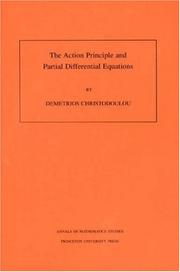
ISBN: 0691049572 0691049564 1400882680 Year: 2000 Volume: no. 146 Publisher: Princeton Princeton University press
Abstract | Keywords | Export | Availability | Bookmark
 Loading...
Loading...Choose an application
- Reference Manager
- EndNote
- RefWorks (Direct export to RefWorks)
This book introduces new methods in the theory of partial differential equations derivable from a Lagrangian. These methods constitute, in part, an extension to partial differential equations of the methods of symplectic geometry and Hamilton-Jacobi theory for Lagrangian systems of ordinary differential equations. A distinguishing characteristic of this approach is that one considers, at once, entire families of solutions of the Euler-Lagrange equations, rather than restricting attention to single solutions at a time. The second part of the book develops a general theory of integral identities, the theory of "compatible currents," which extends the work of E. Noether. Finally, the third part introduces a new general definition of hyperbolicity, based on a quadratic form associated with the Lagrangian, which overcomes the obstacles arising from singularities of the characteristic variety that were encountered in previous approaches. On the basis of the new definition, the domain-of-dependence theorem and stability properties of solutions are derived. Applications to continuum mechanics are discussed throughout the book. The last chapter is devoted to the electrodynamics of nonlinear continuous media.
Differentiaalvergelijkingen [Hyperbolische ] --- Differential equations [Hyperbolic] --- Equations différentielles hyperboliques --- Symplectic manifolds --- Differential equations, Hyperbolic. --- Symplectic manifolds. --- Variétés symplectiques --- Equations différentielles hyperboliques --- Variétés symplectiques --- Manifolds, Symplectic --- Geometry, Differential --- Manifolds (Mathematics) --- Hyperbolic differential equations --- Differential equations, Partial --- Action (physics). --- Boundary value problem. --- Canonical form. --- Causal structure. --- Classical mechanics. --- Complex analysis. --- Configuration space. --- Conservative vector field. --- Conserved current. --- Conserved quantity. --- Continuum mechanics. --- Derivative. --- Diffeomorphism. --- Differentiable manifold. --- Differential geometry. --- Dimension. --- Dimensional analysis. --- Dirichlet's principle. --- Einstein field equations. --- Electromagnetic field. --- Equation. --- Equations of motion. --- Equivalence class. --- Error term. --- Euclidean space. --- Euler system. --- Euler's equations (rigid body dynamics). --- Euler–Lagrange equation. --- Existence theorem. --- Existential quantification. --- Exponential map (Lie theory). --- Exponential map (Riemannian geometry). --- Exterior derivative. --- Fiber bundle. --- Foliation. --- Fritz John. --- General relativity. --- Hamiltonian mechanics. --- Hamilton–Jacobi equation. --- Harmonic map. --- Hessian matrix. --- Holomorphic function. --- Hyperbolic partial differential equation. --- Hyperplane. --- Hypersurface. --- Identity element. --- Iteration. --- Iterative method. --- Lagrangian (field theory). --- Lagrangian. --- Legendre transformation. --- Lie algebra. --- Linear approximation. --- Linear differential equation. --- Linear map. --- Linear span. --- Linearity. --- Linearization. --- Maximum principle. --- Maxwell's equations. --- Nonlinear system. --- Open set. --- Ordinary differential equation. --- Orthogonal complement. --- Parameter. --- Partial differential equation. --- Phase space. --- Pointwise. --- Poisson bracket. --- Polynomial. --- Principal part. --- Principle of least action. --- Probability. --- Pullback bundle. --- Pullback. --- Quadratic form. --- Quantity. --- Requirement. --- Riemannian manifold. --- Second derivative. --- Simultaneous equations. --- Special case. --- State function. --- Stokes' theorem. --- Subset. --- Surjective function. --- Symplectic geometry. --- Tangent bundle. --- Tangent vector. --- Theorem. --- Theoretical physics. --- Theory. --- Underdetermined system. --- Variable (mathematics). --- Vector bundle. --- Vector field. --- Vector space. --- Volume form. --- Zero of a function. --- Zero set.
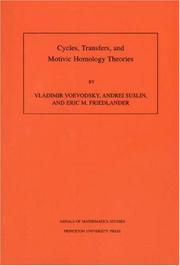
ISBN: 0691048142 0691048150 9786613379825 1283379821 140083712X 9780691048147 9780691048154 9781283379823 9781400837120 Year: 2000 Volume: 143 Publisher: Princeton (N.J.): Princeton university press,
Abstract | Keywords | Export | Availability | Bookmark
 Loading...
Loading...Choose an application
- Reference Manager
- EndNote
- RefWorks (Direct export to RefWorks)
The original goal that ultimately led to this volume was the construction of "motivic cohomology theory," whose existence was conjectured by A. Beilinson and S. Lichtenbaum. This is achieved in the book's fourth paper, using results of the other papers whose additional role is to contribute to our understanding of various properties of algebraic cycles. The material presented provides the foundations for the recent proof of the celebrated "Milnor Conjecture" by Vladimir Voevodsky. The theory of sheaves of relative cycles is developed in the first paper of this volume. The theory of presheaves with transfers and more specifically homotopy invariant presheaves with transfers is the main theme of the second paper. The Friedlander-Lawson moving lemma for families of algebraic cycles appears in the third paper in which a bivariant theory called bivariant cycle cohomology is constructed. The fifth and last paper in the volume gives a proof of the fact that bivariant cycle cohomology groups are canonically isomorphic (in appropriate cases) to Bloch's higher Chow groups, thereby providing a link between the authors' theory and Bloch's original approach to motivic (co-)homology.
Bundeltheorie --- Cohomology [Sheaf ] --- Faisceaux [Théorie des ] --- Sheaf cohomology --- Sheaf theory --- Sheaves (Algebraic topology) --- Sheaves [Theory of ] --- Théorie des faisceaux --- Algebraic cycles --- Homology theory --- Algebraic cycles. --- Homology theory. --- Cohomology theory --- Contrahomology theory --- Algebraic topology --- Cycles, Algebraic --- Geometry, Algebraic --- Abelian category. --- Abelian group. --- Addition. --- Additive category. --- Adjoint functors. --- Affine space. --- Affine variety. --- Alexander Grothendieck. --- Algebraic K-theory. --- Algebraic cycle. --- Algebraically closed field. --- Andrei Suslin. --- Associative property. --- Base change. --- Category of abelian groups. --- Chain complex. --- Chow group. --- Closed immersion. --- Codimension. --- Coefficient. --- Cohomology. --- Cokernel. --- Commutative property. --- Commutative ring. --- Compactification (mathematics). --- Comparison theorem. --- Computation. --- Connected component (graph theory). --- Connected space. --- Corollary. --- Diagram (category theory). --- Dimension. --- Discrete valuation ring. --- Disjoint union. --- Divisor. --- Embedding. --- Endomorphism. --- Epimorphism. --- Exact sequence. --- Existential quantification. --- Field of fractions. --- Functor. --- Generic point. --- Geometry. --- Grothendieck topology. --- Homeomorphism. --- Homogeneous coordinates. --- Homology (mathematics). --- Homomorphism. --- Homotopy category. --- Homotopy. --- Injective sheaf. --- Irreducible component. --- K-theory. --- Mathematical induction. --- Mayer–Vietoris sequence. --- Milnor K-theory. --- Monoid. --- Monoidal category. --- Monomorphism. --- Morphism of schemes. --- Morphism. --- Motivic cohomology. --- Natural transformation. --- Nisnevich topology. --- Noetherian. --- Open set. --- Pairing. --- Perfect field. --- Permutation. --- Picard group. --- Presheaf (category theory). --- Projective space. --- Projective variety. --- Proper morphism. --- Quasi-projective variety. --- Residue field. --- Resolution of singularities. --- Scientific notation. --- Sheaf (mathematics). --- Simplicial complex. --- Simplicial set. --- Singular homology. --- Smooth scheme. --- Spectral sequence. --- Subcategory. --- Subgroup. --- Summation. --- Support (mathematics). --- Tensor product. --- Theorem. --- Topology. --- Triangulated category. --- Type theory. --- Universal coefficient theorem. --- Variable (mathematics). --- Vector bundle. --- Vladimir Voevodsky. --- Zariski topology. --- Zariski's main theorem. --- 512.73 --- 512.73 Cohomology theory of algebraic varieties and schemes --- Cohomology theory of algebraic varieties and schemes
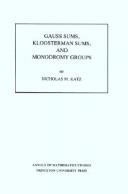
ISBN: 0691084335 0691084327 1400882125 Year: 1988 Volume: vol 116 Publisher: Princeton : Princeton University Press,
Abstract | Keywords | Export | Availability | Bookmark
 Loading...
Loading...Choose an application
- Reference Manager
- EndNote
- RefWorks (Direct export to RefWorks)
The study of exponential sums over finite fields, begun by Gauss nearly two centuries ago, has been completely transformed in recent years by advances in algebraic geometry, culminating in Deligne's work on the Weil Conjectures. It now appears as a very attractive mixture of algebraic geometry, representation theory, and the sheaf-theoretic incarnations of such standard constructions of classical analysis as convolution and Fourier transform. The book is simultaneously an account of some of these ideas, techniques, and results, and an account of their application to concrete equidistribution questions concerning Kloosterman sums and Gauss sums.
Group theory --- Algebraic geometry --- Number theory --- 511.33 --- Analytical and multiplicative number theory. Asymptotics. Sieves etc. --- 511.33 Analytical and multiplicative number theory. Asymptotics. Sieves etc. --- Gaussian sums --- Homology theory --- Kloosterman sums --- Monodromy groups --- Kloostermann sums --- Sums, Kloosterman --- Sums, Kloostermann --- Exponential sums --- Cohomology theory --- Contrahomology theory --- Algebraic topology --- Gauss sums --- Sums, Gaussian --- Analytical and multiplicative number theory. Asymptotics. Sieves etc --- Gaussian sums. --- Kloosterman sums. --- Homology theory. --- Monodromy groups. --- Number theory. --- Nombres, Théorie des. --- Exponential sums. --- Sommes exponentielles. --- Arithmetic --- Arithmétique --- Geometry, Algebraic. --- Géométrie algébrique --- Abelian category. --- Absolute Galois group. --- Absolute value. --- Additive group. --- Adjoint representation. --- Affine variety. --- Algebraic group. --- Automorphic form. --- Automorphism. --- Big O notation. --- Cartan subalgebra. --- Characteristic polynomial. --- Classification theorem. --- Coefficient. --- Cohomology. --- Cokernel. --- Combination. --- Commutator. --- Compactification (mathematics). --- Complex Lie group. --- Complex number. --- Conjugacy class. --- Continuous function. --- Convolution theorem. --- Convolution. --- Determinant. --- Diagonal matrix. --- Dimension (vector space). --- Direct sum. --- Dual basis. --- Eigenvalues and eigenvectors. --- Empty set. --- Endomorphism. --- Equidistribution theorem. --- Estimation. --- Exactness. --- Existential quantification. --- Exponential sum. --- Exterior algebra. --- Faithful representation. --- Finite field. --- Finite group. --- Four-dimensional space. --- Frobenius endomorphism. --- Fundamental group. --- Fundamental representation. --- Galois group. --- Gauss sum. --- Homomorphism. --- Integer. --- Irreducibility (mathematics). --- Isomorphism class. --- Kloosterman sum. --- L-function. --- Leray spectral sequence. --- Lie algebra. --- Lie theory. --- Maximal compact subgroup. --- Method of moments (statistics). --- Monodromy theorem. --- Monodromy. --- Morphism. --- Multiplicative group. --- Natural number. --- Nilpotent. --- Open problem. --- P-group. --- Pairing. --- Parameter space. --- Parameter. --- Partially ordered set. --- Perfect field. --- Point at infinity. --- Polynomial ring. --- Prime number. --- Quotient group. --- Representation ring. --- Representation theory. --- Residue field. --- Riemann hypothesis. --- Root of unity. --- Sheaf (mathematics). --- Simple Lie group. --- Skew-symmetric matrix. --- Smooth morphism. --- Special case. --- Spin representation. --- Subgroup. --- Support (mathematics). --- Symmetric matrix. --- Symplectic group. --- Symplectic vector space. --- Tensor product. --- Theorem. --- Trace (linear algebra). --- Trivial representation. --- Variable (mathematics). --- Weil conjectures. --- Weyl character formula. --- Zariski topology. --- Geometry, Algebraic

ISBN: 0691085420 1400883911 9781400883912 9780691085425 Year: 1989 Volume: 38 Publisher: Princeton (N.J.) : Princeton university press,
Abstract | Keywords | Export | Availability | Bookmark
 Loading...
Loading...Choose an application
- Reference Manager
- EndNote
- RefWorks (Direct export to RefWorks)
This book offers a systematic and comprehensive presentation of the concepts of a spin manifold, spinor fields, Dirac operators, and A-genera, which, over the last two decades, have come to play a significant role in many areas of modern mathematics. Since the deeper applications of these ideas require various general forms of the Atiyah-Singer Index Theorem, the theorems and their proofs, together with all prerequisite material, are examined here in detail. The exposition is richly embroidered with examples and applications to a wide spectrum of problems in differential geometry, topology, and mathematical physics. The authors consistently use Clifford algebras and their representations in this exposition. Clifford multiplication and Dirac operator identities are even used in place of the standard tensor calculus. This unique approach unifies all the standard elliptic operators in geometry and brings fresh insights into curvature calculations. The fundamental relationships of Clifford modules to such topics as the theory of Lie groups, K-theory, KR-theory, and Bott Periodicity also receive careful consideration. A special feature of this book is the development of the theory of Cl-linear elliptic operators and the associated index theorem, which connects certain subtle spin-corbordism invariants to classical questions in geometry and has led to some of the most profound relations known between the curvature and topology of manifolds.
Algebres de Clifford --- Clifford [Algebra's van ] --- Clifford algebras --- Fysica [Mathematische ] --- Fysica [Wiskundige ] --- Mathematische fysica --- Physics -- Mathematics --- Physics [Mathematical ] --- Physique -- Mathématiques --- Physique -- Méthodes mathématiques --- Wiskundige fysica --- Clifford, Algèbres de --- Spin, Nuclear --- Geometric algebras --- Clifford algebras. --- Spin geometry. --- Clifford, Algèbres de --- Spin geometry --- 514.76 --- Algebras, Linear --- 514.76 Geometry of differentiable manifolds and of their submanifolds --- Geometry of differentiable manifolds and of their submanifolds --- Global differential geometry --- Geometry --- Mathematical physics --- Topology --- Nuclear spin --- -Mathematics --- Géométrie --- Physique mathématique --- Spin nucléaire --- Topologie --- Mathematics --- Mathématiques --- Algebraic theory. --- Atiyah–Singer index theorem. --- Automorphism. --- Betti number. --- Binary icosahedral group. --- Binary octahedral group. --- Bundle metric. --- C*-algebra. --- Calabi conjecture. --- Calabi–Yau manifold. --- Cartesian product. --- Classification theorem. --- Clifford algebra. --- Cobordism. --- Cohomology ring. --- Cohomology. --- Cokernel. --- Complete metric space. --- Complex manifold. --- Complex vector bundle. --- Complexification (Lie group). --- Covering space. --- Diffeomorphism. --- Differential topology. --- Dimension (vector space). --- Dimension. --- Dirac operator. --- Disk (mathematics). --- Dolbeault cohomology. --- Einstein field equations. --- Elliptic operator. --- Equivariant K-theory. --- Exterior algebra. --- Fiber bundle. --- Fixed-point theorem. --- Fourier inversion theorem. --- Fundamental group. --- Gauge theory. --- Geometry. --- Hilbert scheme. --- Holonomy. --- Homotopy sphere. --- Homotopy. --- Hyperbolic manifold. --- Induced homomorphism. --- Intersection form (4-manifold). --- Isomorphism class. --- J-invariant. --- K-theory. --- Kähler manifold. --- Laplace operator. --- Lie algebra. --- Lorentz covariance. --- Lorentz group. --- Manifold. --- Mathematical induction. --- Metric connection. --- Minkowski space. --- Module (mathematics). --- N-sphere. --- Operator (physics). --- Orthonormal basis. --- Principal bundle. --- Projective space. --- Pseudo-Riemannian manifold. --- Pseudo-differential operator. --- Quadratic form. --- Quaternion. --- Quaternionic projective space. --- Ricci curvature. --- Riemann curvature tensor. --- Riemannian geometry. --- Riemannian manifold. --- Ring homomorphism. --- Scalar curvature. --- Scalar multiplication. --- Sign (mathematics). --- Space form. --- Sphere theorem. --- Spin representation. --- Spin structure. --- Spinor bundle. --- Spinor field. --- Spinor. --- Subgroup. --- Support (mathematics). --- Symplectic geometry. --- Tangent bundle. --- Tangent space. --- Tensor calculus. --- Tensor product. --- Theorem. --- Topology. --- Unit disk. --- Unit sphere. --- Variable (mathematics). --- Vector bundle. --- Vector field. --- Vector space. --- Volume form. --- Nuclear spin - - Mathematics --- -Clifford algebras. --- -Geometry
| Listing 1 - 6 of 6 |
Sort by
|

 Search
Search Feedback
Feedback About UniCat
About UniCat  Help
Help News
News